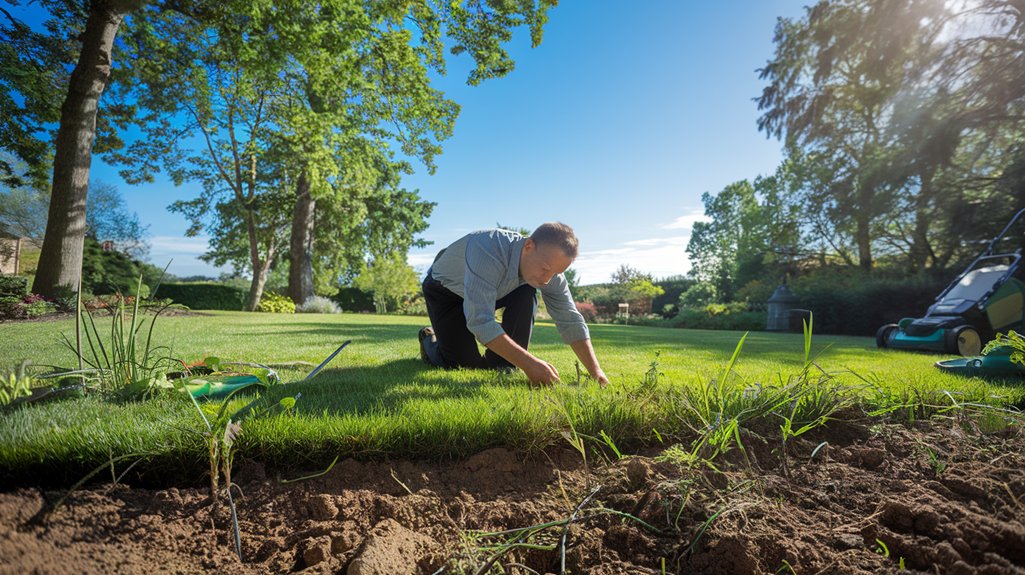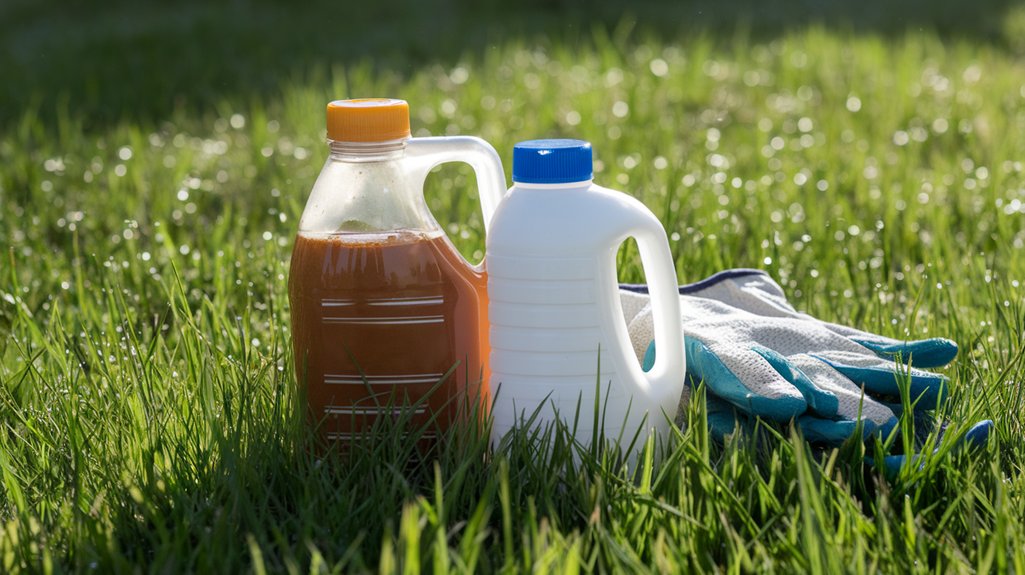Keeping your lawn weed-free all season long isn't just about pulling a few pesky plants here and there. It starts with understanding the types of weeds invading your space and knowing how to combat them effectively. Implementing the right strategies can make a significant difference. But which methods should you prioritize to ensure a lush, green lawn? Let's explore the essentials of effective weed control.
Key Takeaways
- Identify weed types to tailor control methods effectively and enhance lawn health.
- Apply pre-emergent herbicides in spring to prevent weed seed germination.
- Utilize post-emergent treatments promptly on visible weeds for effective control.
- Maintain soil health through proper nutrient management and organic mulch to support grass.
- Regularly monitor lawn conditions and adjust strategies based on weed growth and local weather patterns.
Understanding Weeds: Types and Their Impact on Your Lawn

Weeds are like uninvited guests at a garden party; they show up unannounced and can quickly take over. Understanding the different types of weeds is crucial for your lawn's health.
Annual weeds, like crabgrass, germinate, grow, and die within a year, creating a cycle of lawn competition. Perennial weeds, such as dandelions, stick around year after year, making them harder to control.
Invasive species can also wreak havoc by outcompeting your grass for nutrients and water. If you want a lush lawn, identifying and managing these weeds is key.
The Importance of a Healthy Lawn

A healthy lawn not only enhances your home's curb appeal but also contributes to the overall ecosystem. When you prioritize lawn health, you're fostering a vibrant environment that supports beneficial insects and wildlife.
A robust lawn can improve air quality and reduce soil erosion, making it essential for sustainable living.
Good soil quality is vital in this process; it provides the nutrients your grass needs to thrive. Regularly testing and amending your soil ensures it stays nutrient-rich and well-drained.
By maintaining a healthy lawn, you'll create a resilient landscape that naturally suppresses weeds, reducing the need for chemical interventions.
Ultimately, investing time and effort into your lawn not only beautifies your property but also promotes a healthier environment for everyone.
Pre-Emergent vs. Post-Emergent Weed Control

While you're working to maintain your lawn's health, understanding the difference between pre-emergent and post-emergent weed control is crucial.
Pre-emergent applications are designed to prevent weed seeds from germinating, creating a barrier in the soil. Applying them in early spring can significantly reduce weed populations throughout the season.
On the other hand, post-emergent control targets weeds that have already sprouted. Timing is essential here; you should apply post-emergent treatments when weeds are actively growing for the best results.
Effective Weed Prevention Techniques
Understanding weed control methods lays the groundwork for effective prevention techniques. Start by maintaining your soil health; healthy soil supports robust grass that can outcompete weeds. Next, apply organic mulch around your plants. This not only retains moisture but also suppresses weed growth.
Here's a quick reference table to help you visualize:
| Technique | Benefits | Tips |
|---|---|---|
| Soil Aeration | Improves drainage | Aerate in spring |
| Organic Mulch | Suppresses weeds | Apply 2-3 inches thick |
| Proper Mowing | Encourages growth | Mow at the right height |
| Regular Watering | Maintains moisture | Water deeply but infrequently |
Natural vs. Chemical Weed Control Methods
How do you choose between natural and chemical weed control methods? It often depends on your priorities.
If you're looking for eco-friendly alternatives, organic herbicides might be your best bet. These products use natural ingredients to target weeds without harming beneficial plants or the environment. They're great for those who want a sustainable approach to lawn care.
On the other hand, chemical weed control methods can be more effective for severe infestations. They work quickly and can provide long-lasting results.
However, you should consider potential risks to pets, children, and local wildlife. Ultimately, weigh the benefits and drawbacks of each method to determine which aligns best with your lawn care goals.
Your lawn will thrive when you make an informed choice!
How to Properly Apply Herbicides
Choosing the right weed control method sets the stage for successful herbicide application.
Before you start, make sure to read the label carefully to understand the specific instructions. Wear protective gear, including gloves and a mask, to ensure safety during application.
It's best to apply herbicides on a calm day to prevent drift onto desirable plants. Use a sprayer or spreader for even coverage, targeting the weeds directly while avoiding the grass.
Follow the recommended dosage; using too much can harm your lawn. After application, keep pets and children off the treated area for the specified time.
Manual Weed Removal: Tools and Techniques
Manual weed removal is a straightforward yet effective way to keep your garden or lawn healthy. You can use various hand weeding techniques to tackle pesky weeds.
Start by pulling weeds by hand, ensuring you grab the entire root to prevent regrowth. A weeding fork or a hoe can help with stubborn roots, making the process easier.
Essential tools like gloves protect your hands and a kneeling pad will save your knees from discomfort. Don't forget to regularly check your garden; catching weeds early makes removal simpler.
For best results, aim to weed after rain when the soil is soft. With consistency and the right tools, you'll maintain a beautiful, weed-free lawn all season long.
Maintaining Proper Lawn Care Practices
After you've tackled weeds with your manual removal efforts, maintaining proper lawn care practices is key to keeping your yard healthy and vibrant.
Start by understanding the soil health importance; healthy soil promotes strong grass growth, which naturally outcompetes weeds.
Consider regular lawn aeration to improve air and nutrient flow, enhancing root development. The lawn aeration benefits include reducing compacted soil, allowing water to penetrate deeply and encouraging a robust lawn.
Additionally, ensure you're mowing at the right height—this helps shade out weeds and fosters a lush lawn.
Watering appropriately is crucial too; deep, infrequent watering encourages deeper root systems.
Seasonal Strategies for Weed Control
While weeds can be a persistent challenge, implementing seasonal strategies for weed control can significantly reduce their impact on your lawn.
Start by focusing on seasonal timing; early spring is the perfect time to apply pre-emergent herbicides to prevent weed seeds from germinating.
As temperatures warm in summer, consider spot-treating any emerging weeds with selective herbicides while monitoring the weather considerations, as hot conditions can make some treatments less effective.
In fall, overseed your lawn to promote healthy grass growth, which will naturally outcompete weeds.
Always adjust your strategies based on local weather patterns, ensuring your approach is both timely and effective.
Monitoring and Adjusting Your Weed Control Plan
As you implement your weed control plan, regularly monitoring its effectiveness is crucial to achieving the best results. Keeping an eye on your lawn allows you to spot problem areas and make necessary plan adjustments.
| Monitoring Task | Frequency | Adjustment Action |
|---|---|---|
| Inspect lawn | Weekly | Identify weed types |
| Assess treatment | Bi-weekly | Adjust herbicide strength |
| Evaluate results | Monthly | Change application methods |
Frequently Asked Questions
Can Weeds Thrive in Shaded Areas of My Lawn?
Yes, weeds can thrive in shaded lawns. Types like clover and creeping Charlie often flourish in lower light conditions. To keep your lawn healthy, regularly monitor these areas and manage them effectively to prevent weed growth.
How Often Should I Mow to Prevent Weed Growth?
To prevent weed growth, you should mow regularly, ideally every week during peak growth. Aim for a mowing frequency that maintains your grass at an ideal height, usually around three inches, ensuring a healthy lawn.
Do Certain Grass Types Resist Weeds Better Than Others?
Yes, certain grass types offer better resilience against weeds. By focusing on turf selection, you can choose varieties that thrive in your climate, making it harder for weeds to establish and compete with your lawn.
What Are Common Signs of Weed Infestations?
To spot weed infestations, watch for uneven growth, discolored patches, and invasive species. Use weed identification tips alongside lawn health indicators to assess your lawn's condition and determine if intervention's needed for optimal results.
How Does Weather Affect Weed Growth in My Lawn?
Weather patterns and seasonal changes significantly influence weed growth in your lawn. Warm, wet conditions encourage rapid growth, while cooler, drier weather can slow it down. Monitoring these factors helps you manage weeds effectively.
Conclusion
By staying proactive and informed, you can keep your lawn healthy and weed-free all season long. Remember to identify the weeds you're dealing with, use pre-emergent and post-emergent treatments wisely, and embrace natural methods alongside chemical ones. Regular inspections and adjustments to your weed control plan will ensure your efforts pay off. With consistent care and attention, you'll enjoy a lush, vibrant lawn that stands strong against invasive weeds. Happy lawn caring!
